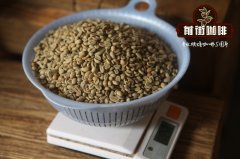Tonality of natural fruits | the planting of Chelelektu in Yega Snow Fay, Ethiopia

Professional coffee knowledge exchange more coffee bean information please follow the coffee workshop (Wechat official account cafe_style)
The tonality of natural fruit | the planting story of Chelelektu in Ethiopia Yega Xuefei? Description of flavor and taste?
Produced by many small-scale farmers in Ethiopia's famous Yirgacheffe region, this special wet craft variety of heirloom coffee is grown more than 1800 meters above sea level. Natural Yirgacheffe Gr of Ethiopia. 1 Chelelektu comes from a family farm around the Chelelektu factory in Kochere woreda, Gedeo region, Ethiopia. The Gedeo district is named after the Gedeo people, who are indigenous people of the area. The Kochere microdomain has long been considered one of the best origins of coffee in southern Ethiopia. The combination of very high altitude and iron-rich acidic soil creates ideal growth conditions to produce bright, floral, from Chelelektu station, located in the middle of Gediyo district in southern Ethiopia, bordering Kochere Woreda (woredas is a third-level administrative division, collection area) and Guji district. .
Ethiopia is a country famous for the quality of Arabica coffee. The climate, altitude and culture available to Ethiopian farmers give them a considerable advantage over their peers in other parts of the world. Yirgacheffe exemplifies these qualities. It is part of the Sidamo region and is located in the mountains of the south of the country. The coffee that originated there enjoys such an excellent reputation that Yirgacheffe enjoys its informal status as its own region. The area is fertile and high, and most of the coffee here covers an area of more than 2000 marks.
This beautiful and delicious natural Yirgacheffe shows the diversity of this amazing region, which has the oldest plant species in the world.
Buying from Ethiopia is still a challenge for us, but the cupping table continues to show us some amazing Ethiopian coffee. However, it is still difficult to buy through the Ethiopian Commodity Exchange. If you need some coffee traceability or backstory, you must become a detective. This is a very good job, I am becoming very good at finding clues!
The coffee comes from about 600 small farmers, each of whom have about two hectares of land. Coffee cherries are carefully selected and coffee is grown at an altitude of about 1850-1950 meters. The small farmers then sold the freshly picked cherries to the Chelelektu factory.
Ripe cherries are sent to the factory. There, they are graded, and then they are placed on a thin layer of elevated drying beds and rotate every 2-3 hours in the first few days to avoid overfermentation and mold growth; 4-6 weeks later (depending on the weather and temperature) beans are shelled before being transported to Addis in parchment and then ground before transportation.
About 85% of Ethiopians still depend on agriculture for a living, and most of the coffee production in this part of the world is done by small farmers, who each control only a few hectares. Harvesting usually takes place in November, and washed coffee like this is usually a few hours after picking-usually at night. They are sorted in a fermentor, then fermented for 16 to 48 hours, then sorted again and dried in an elevated bed in the sun.
The Gedeo district of Yirgacheffe is famous for its premium coffee, which is grown by small farmers and usually covers an area of less than 1.5 hectares. The area has amazing fertile soil, high iron content and deep roots, enabling coffee plants to get the most nutrients from the ground. High iron content is an important part of photosynthesis, which means that coffee plants are more likely to produce more cherries. Small farmers here collect ripe red cherries between April and May and transport them to Chelelektu washing stations, where they are sorted and laid on dry elevated beds for 18-22 days. After that, the coffee is shelled and classified to identify defects, and then placed in the outer parchment layer for 60 days before export.
Flavor: clean, well-balanced, with a little front berry / melon hue. Although it is highly acidic at very light baking spots, once you enter the city barbecue, it will not be as acidic as some of its cousins-it will release more honey like honey than raw citrus-very good cups. Crisp and floral, with strong fruit tones and a hint of dark chocolate on the light barbecue. The Fuller barbecue gives it more body, with some darker fruit tones, but with a hint of citrus and awe-inspiring fruit. It is soft and explosive, almost sweet and deep. The dry aroma brings the iconic bergamot and some dried fruits and roasted almonds. Clean, full of energy. Brewing you will find a refreshing but not dominant lemon acidity, subtle aromas of jasmine, and even some hops quality, creamy body and smooth honey flavor, aftertaste of plums and fresh raspberries.
Important Notice :
前街咖啡 FrontStreet Coffee has moved to new addredd:
FrontStreet Coffee Address: 315,Donghua East Road,GuangZhou
Tel:020 38364473
- Prev

Citrus sour Ethiopia | Yega Xuefei YirgacheffeChelelektu
Professional coffee knowledge exchange more coffee bean information please follow the coffee workshop (Wechat official account cafe_style) citrus sour Ethiopia | Yega Xuefei production area Xueyitu YirgacheffeChelelektu coffee bean characteristics and flavor? Chelelektu will return to the warehouse in Antwerp this year! For the second year in a row, we provided a lot at Kochere, a famous laundry station.
- Next

The taste is outstanding. How high is the altitude of the cultivation of Rosario flor del rosario in Guatemala? Luo
Professional coffee knowledge exchange more coffee bean information please follow the coffee workshop (Wechat official account cafe_style) taste outstanding | how high is the altitude of Rosalio flor del rosario in Guatemala? How do Rosalio coffee beans taste? Finca La Flor del Rosario coffee was grown by farmer and owner Horst Spitzke in 1988 / 1989. Except for coffee.
Related
- Detailed explanation of Jadeite planting Land in Panamanian Jadeite Manor introduction to the grading system of Jadeite competitive bidding, Red bid, Green bid and Rose Summer
- Story of Coffee planting in Brenka region of Costa Rica Stonehenge Manor anaerobic heavy honey treatment of flavor mouth
- What's on the barrel of Blue Mountain Coffee beans?
- Can American coffee also pull flowers? How to use hot American style to pull out a good-looking pattern?
- Can you make a cold extract with coffee beans? What is the right proportion for cold-extracted coffee formula?
- Indonesian PWN Gold Mandrine Coffee Origin Features Flavor How to Chong? Mandolin coffee is American.
- A brief introduction to the flavor characteristics of Brazilian yellow bourbon coffee beans
- What is the effect of different water quality on the flavor of cold-extracted coffee? What kind of water is best for brewing coffee?
- Why do you think of Rose Summer whenever you mention Panamanian coffee?
- Introduction to the characteristics of authentic blue mountain coffee bean producing areas? What is the CIB Coffee Authority in Jamaica?

